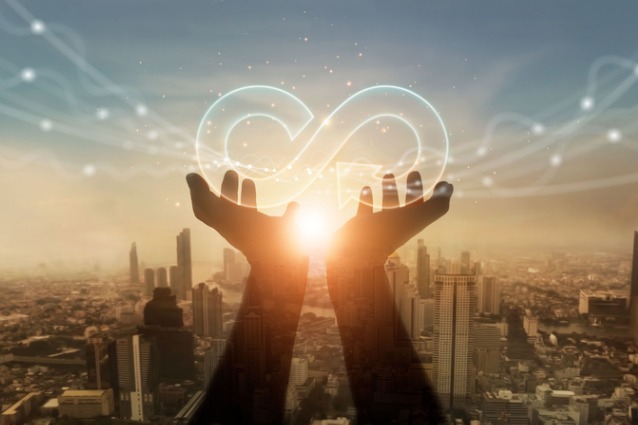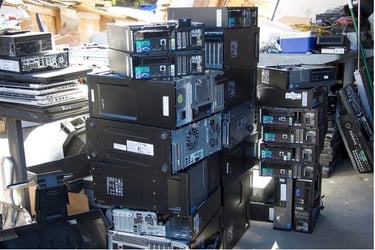Is your business becoming more aware of its e-waste contributions? Are you looking to reduce it in alignment with your ESG (Environmental, Social, and Governance) and CSR (Corporate Social Responsibility) objectives?
The advances in technology mean it’s now quicker to share information online than it used to be for the old dial-up to connect. ‘Viral’ was a dreaded word reserved for health conditions but now applies to the mass consumption of a piece of content.
The pressure is on because exposure of your data and environmental impact might be taken out of your hands. Businesses need to ensure their ethical laundry is clean before it’s aired in public, damaging your brand and reputation.
Ingram Micro Lifecycle supports thousands of businesses across the globe to enable a circular economy for their IT, mobility, and electronic equipment. This switch provides evidence for sustainability objectives, including carbon emission savings, e-waste reduction, and downstream infrastructure flows.
Below, we discuss why the current linear economy isn’t sustainable and how becoming more circular with your technology supports your sustainability goals.
What's wrong with the current linear economy?
A linear economy follows the take-make-waste mantra. Natural resources are mined from the earth, used, and then discarded.
The UN estimates that around 7% of gold mined from the earth is lying within e-waste, and that one tonne of e-waste contains 100 times more gold than one tonne of gold ore. Precious metals are ten times more abundant in printed circuit boards than in natural ores. Some technology uses up to 60 different periodic elements.
Not only is the end-of-life of products putting a strain on the environment, but the creation does too. The linear economy puts huge pressure on manufacturing and resources for swift production.
Consumer demand increases manufacturing. This in turn emits more CO2 and other greenhouse gases as a by-product. If we reduced the frequency of buying new products, manufacturing would also decrease. Materials intended for manufacturing could instead be used for creating more sustainable goods or technologies.
For example, some of the materials used within smartphones are also used in renewable energy equipment. Fewer new smartphones = more renewable energy equipment.
These materials, if the victim of a linear economy, go straight to landfills and are lost.
Introducing the circular economy
Have you seen the reusable cups sold in popular coffee shop chains? These are often incentivized with a discount when you present one when you order. This is an example of a circular economy.
The single-use cup the shop would have used previously as standard has a linear lifecycle. This means it would become waste after its short lifecycle. The heavy-duty version has a circular lifecycle, as you’ll take it back the next time you visit the chain and reuse it.
You’ll take full advantage of that discount and know you’re reducing landfill at the same time. Cue a warm, fuzzy feeling.
A circular economy takes a commodity that would become waste after one use, and prolongs its lifecycle, retaining value and use for longer. It postpones the refresh point when a replacement is needed. A circular economy promotes reuse and recycling, extending the life cycle of those materials and reducing the pressure to obtain more from natural sources.
Meeting sustainability objectives
We’re all becoming more conscious of how our behavior affects the world around us. As our awareness and education increase, so too does the call to step up and do more to eradicate harmful practices. Sustainability is becoming expected, a necessity, rather than a luxury.
As a result, we’ve seen the rise of the term ‘greenwashing’. This is where businesses provide misleading information to inflate their sustainability commitments.
Your sustainability targets are data-driven and measurable. It’s red numbers and green numbers, hitting targets or failing. It removes the grey areas that you could hide in and holds you accountable.
What is CSR?
Corporate Social Responsibility is typically broken down into:
- Environment
- Society
- Philanthropy
- Ethics
Promoting CSR can lead to improvements on the triple bottom line- people, planet, and profit.
CSR is largely qualitative and self-assessed. These objectives create a healthy workplace culture, support decision-making processes, and guide company values.
CSR supports a team to become inclusive and motivated, ultimately with boosted performance and efficiencies. Objectives within CSR policies often go on to inform the more measurable ESG initiatives.
The evolution of CSR to ESG
From CSR (Corporate Social Responsibility) came a new set of pillars. ESG (Environmental, Social, and Governance). These need a strategic, quantitative approach as opposed to qualitative. ESG performance is often assessed and evaluated by potential investors.
5 ways circularity ties in with sustainability goals
Below, we’ve grouped 5 key ways that switching to a circular economy will support the efforts of your CSR and ESG goals. We’ve grouped the similar categories from each objective set together.
Corporate and Governance
These aspects cover the competitive approach to the market that the business takes and the tactics it employs. These keep it in line with fair and ethical practices. This involves corporate training, managerial conduct, compliance, and accreditations that the business seeks.
1. Ensure any partners you use for practices such as e-waste handling and data wiping are ethical and compliant. Look for those adhering to industry-leading standards and retaining accreditations.
Social
This includes targets that empower the people around you. This includes those within your company and those impacted by it, honoring and protecting human rights. This includes policies around staff welfare, employee personal development, and philanthropic activities. It also covers cybersecurity, as data breaches can lead to identity theft and impact the economy.
2. Ensure any partner you use for e-waste handling is compliant with local laws. Employees need safe and suitable working conditions.
3. You can donate any used devices that you don't wish to keep to a good cause. For example, for use in lesser developed countries. Or you could sell your data-wiped, used devices and donate the funds to a charitable cause.
Environmental
This looks at limiting the negative impact on physical surroundings that stem from your business operations, including waste generation and how it’s processed, contamination of soil and water by chemicals released, and greenhouse gas emissions into the atmosphere.
4. Minimizing your e-waste contributions is a huge part of this. Switching to circularity enables the reduction.
5. By extending the lifecycles of your technology, you increase your CO2 avoidance. By choosing not to buy new, you avoid the carbon footprint of the manufacturing process. This also covers the logistics of getting the devices to you and out into the field of any remote workers you have.
Ready to switch to circularity and increase your sustainability?
There are cost advantages too. Investing in one reusable coffee cup that could last you a lifetime is more cost-effective than buying single-use cups for the rest of your life. The upfront cost of the reusable cup may be higher than the single-use, but over time you’d spend more on single-use cups. Say goodbye to false economies.
The coffee cup isn’t the only example of promoting a circular economy that’s become more integrated into society. What others can you think of?
Investing in goods that are made to last and the services that enable this, ensure you’re less likely to need a replacement. You’ll also cut your waste footprint.
Interested in this topic? Check out these related articles:
- How can your business reduce corporate e-waste in 2023?
- 7 reasons why consumers are switching from new to refurbished devices
- What is e-waste? (the environmental toll of our tech habits)
If you’re ready to discuss switching to a more sustainable approach for your IT assets, get in touch with us.











.jpg?width=450&height=250&name=used%20computer%20hardware%20in%20garbage%20(1).jpg)
.jpg?width=450&height=250&name=electronic-waste-ready-for-recycling-pile-of-used-electronic-and-housewares-waste-division.jpg_s=1024x1024%26w=is%26k=20%26c=BnDjFzMKOiAUmT8y-l4cYaPizJzYfU1JS1QsDz5ApIU=%20(1).jpg)
